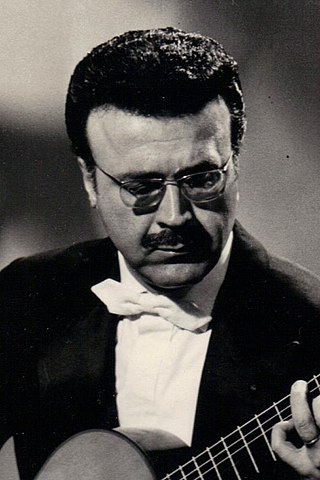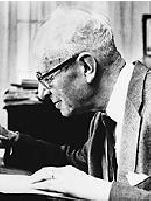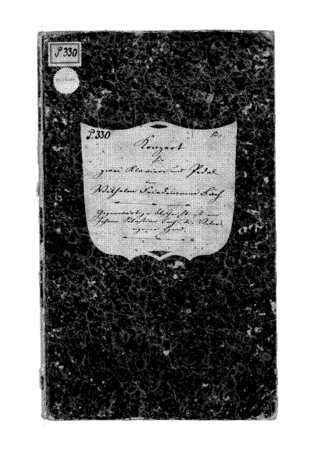Related Research Articles

Andrés Segovia Torres, 1st Marquis of Salobreña was a Spanish virtuoso classical guitarist. Many professional classical guitarists were either students of Segovia or students of Segovia's students. Segovia's contribution to the modern-romantic repertoire included not only commissions but also his own transcriptions of classical or baroque works. He is remembered for his expressive performances: his wide palette of tone, and his distinctive musical personality, phrasing and style.

Toccata is a virtuoso piece of music typically for a keyboard or plucked string instrument featuring fast-moving, lightly fingered or otherwise virtuosic passages or sections, with or without imitative or fugal interludes, generally emphasizing the dexterity of the performer's fingers. Less frequently, the name is applied to works for multiple instruments.

Henryk Bolesław Szeryng was a Polish-Mexican violinist.
Karl Richter was a German conductor, choirmaster, organist, and harpsichordist.
This is a list of notable events in music that took place in the year 1731.

Alexandre Lagoya was a French classical guitarist and composer. His early career included boxing and guitar, and as he cites on the sleeve of a 1981 Columbia album, his parents hoped he would outgrow his predilection for both.

Mischa Elman was a Russian-American violinist famed for his passionate style, beautiful tone, and impeccable artistry and musicality.

Mario Castelnuovo-Tedesco was an Italian composer, pianist and writer. He was known as one of the foremost guitar composers in the twentieth century with almost one hundred compositions for that instrument. In 1939 he emigrated to the United States and became a film composer for Metro-Goldwyn-Mayer for some 200 Hollywood movies for the next fifteen years. He also wrote concertos for Jascha Heifetz and Gregor Piatigorsky.
The year 1714 in music involved some significant events.
A minor is a minor scale based on A, B, C, D, E, F, and G. Its key signature has no flats and no sharps. Its relative major is C major and its parallel major is A major.
E minor is a minor scale based on E, consisting of the pitches E, F♯, G, A, B, C, and D. Its key signature has one sharp, on the F. Its relative major is G major and its parallel major is E major.
B minor is a minor scale based on B, consisting of the pitches B, C♯, D, E, F♯, G, and A. Its key signature has two sharps. Its relative major is D major and its parallel major is B major.

Johann Ernst of Saxe-Weimar was a German prince, son by his second marriage of Johann Ernst III, Duke of Saxe-Weimar. Despite his early death he is remembered as a collector and commissioner of music and as a composer, some of whose concertos were arranged for harpsichord or organ by Johann Sebastian Bach, who was court organist in Weimar at the time.

Váša Příhoda was a Czech violinist and minor composer. Considered a Paganini specialist, his recording of the Violin Concerto in A minor by Dvořák is still praised.
Les Guitares bien tempérées, Op. 199, for two guitars, is a work written in 1962 by Mario Castelnuovo-Tedesco. It consists of 24 pairs of preludes and fugues, one pair in each of the 24 major and minor keys. The 24 pieces are divided into four books. It has been described as the longest and most important cycle of works ever composed for two guitars. It was both inspired by and a tribute to Johann Sebastian Bach's The Well-Tempered Clavier, a work for solo keyboard.
This is the discography for Australian-British guitarist John Christopher Williams. In the following list, compilations or re-editions are denoted by (C) after the album title.
The concerto transcriptions of Johann Sebastian Bach date from his second period at the court in Weimar (1708–1717). Bach transcribed for organ and harpsichord a number of Italian and Italianate concertos, mainly by Antonio Vivaldi, but with others by Alessandro Marcello, Benedetto Marcello, Georg Philipp Telemann and the musically talented Prince Johann Ernst of Saxe-Weimar. It is thought that most of the transcriptions were probably made in 1713–1714. Their publication by C.F. Peters in the 1850s and by Breitkopf & Härtel in the 1890s played a decisive role in the Vivaldi revival of the twentieth century.

The organ concertos of Johann Sebastian Bach are solo works for organ, transcribed and reworked from instrumental concertos originally composed by Antonio Vivaldi and the musically talented Prince Johann Ernst of Saxe-Weimar. While there is no doubt about the authenticity of BWV 592–596, the sixth concerto BWV 597 is now probably considered to be spurious. Composed during Bach's second period at the court in Weimar (1708–1717), the concertos can be dated more precisely to 1713–1714.
References
- ↑ Maurice J. Summerfield: The Classical Guitar. Its Evolution, Players and Personalities Since 1800, 5th edition (Blaydon-on-Tyne: Ashley Mark Publishing Co., 2002), p. 143.
- ↑ Decca CD 440 678-2, Nicola Hall - The Art of the Guitar, liner notes, p. 6
- ↑ "Archived copy". Archived from the original on 26 September 2016. Retrieved 11 March 2013.
{{cite web}}: CS1 maint: archived copy as title (link)